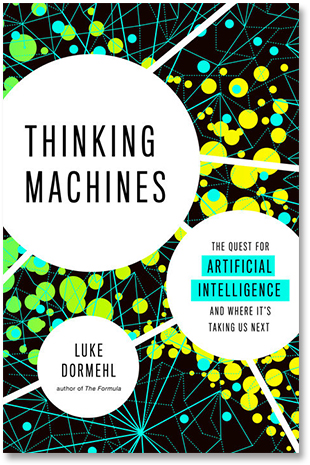Thinking Machines, book review: AI, past, present and future


Thinking Machines: The Quest for Artificial Intelligence and Where It's Taking Us Next • By Luke Dormehl • Tarcher Perigee • 275pages • ISBN: 978-0-14-313058-1 • $16
The Future of Humanity Institute researcher Anders Sandberg has said that we talk about 'artificial intelligence' only until it works; thereafter we call it 'automation'. How smart, for example, is a computer that can win at chess, Jeopardy, or even Go when it can't extrapolate from its knowledge of those games to tackle something else? Our inner biological supremacists can smugly dismiss those computers as automation.
At the beginning of Luke Dormehl'sThinking Machines: The Quest for Artificial Intelligence and Where It's Taking Us Next, 'computers' are people whose actuarial jobs require them to perform complex calculations. By the end, the scientists he interviews are discussing a future in which computers may be a lot like people. In between, Dormehl reviews how the field has developed.
In 1956, the Dartmouth College conference convened by John McCarthy, Marvin Minsky, Claude Shannon, and Nathaniel Rochester thought that significant advances could be made if a selected group of scientists collaborated for a summer. With hindsight, it seems clear they were taking on a much bigger project than they imagined, when they said, in the proposal, that the basis was "the conjecture that every aspect of learning or any other feature of intelligence can in principle be so precisely described that a machine can be made to simulate it".
Maybe it can be that precisely described -- but as it turns out, we still don't fully understand the brain function we're trying to design computer systems to match.
Timely warnings
Dormehl continues through early expert systems, early neural networks, the 'AI winter', the recent renaissance of neural networks, and on to transhumanism, brain uploading, and the Singularity. Dormehl reviews current debates: employment, ethics, and transparency. It's only in the latter discussion, at the end of the book, that the two most familiar examples of fictional AI -- the 1968 Stanley Kubrick film 2001: A Space Odyssey and Isaac Asimov's Three Laws of Robotics -- make their appearance.
If you've been following the development of artificial intelligence all along, Dormehl's book won't have much that's new for you. If you haven't, however, it provides a pretty good introduction to the beginnings of the field, how it has developed, some possible futures it may bring, and a few timely warnings.
Obviously, many advances have been made in the last 25 years. We can now issue instructions to voice assistants in the reasonable expectation that they will respond appropriately a fair percentage of the time. Computers can win against the very best human players of some genuinely difficult games. And deep neural networks can study millions of photographs and figure out which ones are cats even without pre-programming.
And yet...the outline of Dormehl's book isn't so different from Ed Regis's vastly more entertaining 1990 book Great Mambo Chicken and the Transhuman Condition. The biggest difference is that in 1990 you could read Regis's book as wild satire. No chance of that with Dormehl. As he says, a lot of this stuff is real now.
Read more book reviews